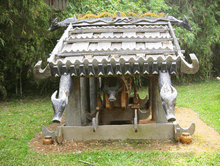Katu people
| Total population | |
|---|---|
| (83,600 (est.)) | |
| Regions with significant populations | |
| Vietnam, Laos | |
| 61,588 (2009)[1] | |
| 22,000 (2005)[2] | |
| Languages | |
| Katu, Phuong, others | |
| Religion | |
| Traditional Religion (Animism), Christianity | |
| Related ethnic groups | |
| Pacoh, Brao, Ta Oi | |
The Katu people (also Co Tu, Ca Tang; Vietnamese: người Cơ Tu) are an ethnic group of about 83,600 who live in eastern Laos and central Vietnam. Numbered among the Katuic peoples, they speak a Mon-Khmer language.
Laos
The Katu in Laos live in Sekong Province along the upper Sekong River and in the highland basin of the Song Boung river watershed along the border with Vietnam's Quảng Nam and Thừa Thiên–Huế Provinces.
Vietnam

The Vietnamese government's official name for the Katu ethnic group is "Co Tu". Within Vietnam, most Katu live in the provinces of Thừa Thiên–Huế and Quảng Nam. The Katu in Vietnam numbered 50,458 in the 1999 census[3] and 61,588 in the 2009 census.[4]
The Katu typically serve rice cooked in bamboo stems such as zăr, aví hor, koo dep, koo gdhoong, and cha chắc, and drink a beverage called tavak. Their famous dances are tung tung (performed by males) and ya yá (performed by females). They play h'roa in ordinary life. Traditional Katu homes are on stilts and those who live on the Laotian border are known for growing jute and weaving. Some 15,000 Katu in Thừa Thiên–Huế speak Phuong, a Katuic dialect often recognized as a separate language.[5]
References
- ↑ "The 2009 Vietnam Population and Housing Census: Completed Results". General Statistics Office of Vietnam: Central Population and Housing Census Steering Committee. June 2010. p. 134. Retrieved 26 November 2013.
- ↑ 2005 Lao Census, cited in Ethnologue
- ↑ Census 1999, file 42.DS99.xls
- ↑ Census 2009, Hanoi, June 2010. Table 5 (POPULATION BY URBAN/RURAL RESIDENCE, SEX, ETHNIC GROUP, SOCIO-ECONOMIC REGION AND PROVINCE/CITY, 1/4/2009), pp. 134. Access Feb 12, 2011.
- ↑ Phuong at Ethnologue (18th ed., 2015)
- Lưu Hùng. 2007. A contribution to Katu ethnography. Hanoi: Nhà xuất bản Thế Giới.